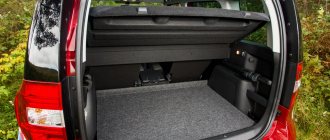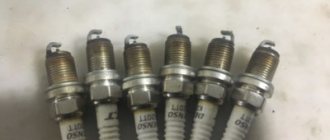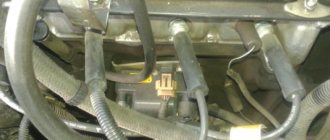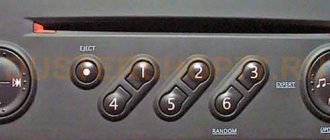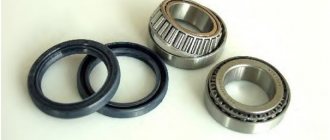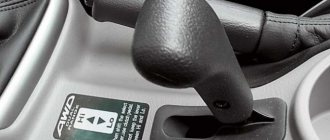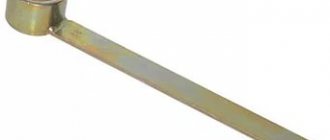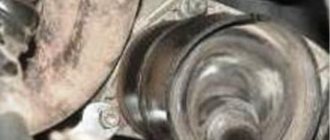Technical features of the models
Externally and in size, both cars are not very different, if you do not take into account design delights - both have a station wagon body and have approximately the same height. But the Duster is noticeably longer – 4315 mm. versus 4056 mm, which greatly affected, among other things, the comfort of the cabin and the spaciousness of the trunk. It is also a couple of centimeters wider and has a slightly higher ground clearance - 210 mm. versus 200 for the Chevrolet Niva.
Niva is available only with all-wheel drive, one 1.7-liter engine, and a manual transmission. Duster has many modifications - 2 gasoline engines and one diesel, with rear-wheel drive or all-wheel drive.
Which is better in terms of technical components – Chevrolet Niva or Renault Duster? It is worth noting that the Duster offers a greater choice of options, and if we compare the all-wheel drive model with the Niva, it clearly wins. At least because Niva has all the diseases of a domestic car - the low quality of many components, and therefore low reliability. On a long trip, even in a new Niva, you will often have to repair something, and not always on small things. But it has its advantages, and the main thing is cross-country ability.
Story
People first started talking about the Chevrolet Niva back in 1998, when a concept car was presented at the capital's auto show. However, due to the economic crisis, the Russian concern could not launch mass production until the American giant General Motors offered cooperation in 2002. A new enterprise, GM-Avtogaz, was created, which owned the rights to produce the new product (by the way, in order to avoid controversial situations, the old Niva model was called “4x4”).
In 2009, the model underwent a major restyling, as a result of which it received an updated design and more configuration options. After the release of several special modifications of the Niva, the debut of the second generation car was expected in 2016. The new model was supposed to have improved technical characteristics, as well as design, but the unstable economic situation prevented the developers from implementing their plans.
Compared to the Chevrolet Niva, Renault Duster seems like a “youngster”, since its production began relatively recently - in 2009. The design of the French crossover is based on the modular B0 platform. For those who don’t know, it was also used by the Nissan Beetle. At first glance, it may seem that this is not the best decision of the developers, but, as practice has shown, they were not mistaken.
In 2013, the French carried out a major modernization that affected almost all aspects of the model. Renault enterprises have always been famous for their productivity, and it is not surprising that until 2014, a total of 1,000,000 Duster units were assembled. By the way, the name of the model is literally translated as “boot.” It’s not hard to guess that this is another way for marketers to emphasize the crossover’s high cross-country ability under any road conditions.
What to choose – Chevrolet Niva or Renault Duster? If we talk exclusively about career success, then this is more likely a Duster.
Appearance
Both models have one similarity - a station wagon, 5-door, and can accommodate 5 people. But in terms of external design, there are still differences. The Duster is a little wider, higher, and longer, its ground clearance is also 1 centimeter higher - 210 m versus 200 for the Niva.
The difference in the contours of both cars is much more noticeable. Chevrolet looks much simpler; there are no unnecessary details or design delights in its appearance.
Duster looks a little more brutal, more masculine. But this model is much more modern - it began to be produced in 2014, 5 years later than the Niva. Here the designers worked a little more and the car looks quite modern.
Salon and trunk
If we compare the interiors of Chevrolet Niva vs Renault Duster, then both do not differ in any chic that owners of, for example, sedans are accustomed to. The furnishings in them are quite spartan; both models have seats without lateral support. The difference is in the finishing and its quality.
Chevrolet Niva interior
The Niva's trim is mostly plastic, although the parts fit well and don't rattle while driving. The dashboard is simple, familiar to those who have owned other VAZ cars. But there is not enough space for rear passengers - there is nowhere for them to put their legs, the space is too cramped even for a person of average height. And the driver's seat is a bit hard, which is especially noticeable on a long trip. But the review is excellent.
The leather interior of the Renault Duster is more comfortable and noticeably superior, including in terms of convenience for rear passengers. The dashboard is more modern and looks nicer. The review is slightly worse than that of its competitor, but this is perhaps the only negative. Although the interior is more comfortable, it cannot be called spacious - a tall person will feel cramped in it, especially while driving.
Salon Renault Duster
As for the trunk, its volume in the Renault Duster is 408 liters, while in the Chevrolet Niva it is only 320 liters. At the same time, in Duster it is longer, but narrower, while in Niva it is short and very small. In this regard, the Duster wins noticeably, as it allows you to load not only more, but also put longer things, and not just a couple of square boxes.
Visual component
If we talk about the American car, then in comparison with the standard Niva it has undergone quite a lot of changes. First of all, it looks much better from a visual point of view. There are a lot more European accents here. The car's interior is designed in a classic style. There's nothing special here. In the standard version of the car, only everything necessary is installed. The interior is lined with the simplest version of fabric, so in this regard, the domestic counterpart lags significantly behind its foreign counterpart. The dashboard looks quite good, although it clearly lacks quality elements.
Photo of Renault Duster interior
French Renault offered a much more stylish and high-quality version of the car. Very interesting and unusual elements appeared here, such as LED headlights, a high-quality bumper and larger wheels compared to the Niva. The car's interior also looks much more attractive, although in this case there is no particular luxury in the elements.
Both cars really deserve attention, and you should choose only based on your own preferences and taste.
Engines and transmissions
The main feature that distinguishes both cars is that Duster has more modifications, including with a diesel engine and all-wheel drive or only rear-wheel drive. Niva has no choice - there is only one engine, and all-wheel drive, which cannot be switched off.
Engine Renault Duster
The Duster can be equipped with a 1.6-liter engine producing 102 hp. With. or the more popular petrol 2-liter with 135 hp. With. Less common is a 1.5-liter diesel engine producing 90 hp. s, which, by the way, is extremely economical.
Niva does not provide a choice - a 1.7-liter gasoline engine with 90 hp. With. has been in use for decades, although it has been slightly modified. It was equipped with an electronic gas pedal, exhaust emissions were brought up to Euro-3 requirements, and the layout of some parts was slightly changed. Otherwise, it’s still the same engine that many are familiar with from old VAZ models. By the way, its advantage in the form of inexpensive repairs anywhere and using the simplest means should not be discounted.
As for the drive, the Duster also has options, including all-wheel drive, and it is implemented very reliably. It is almost impossible to burn the clutch, since the all-wheel drive is turned off using a special timer that measures the slipping time and its intensity. The system is very durable and does not cause any complaints. Although this car is not intended to be an SUV, it can cope with many obstacles if necessary.
Niva has no options - all-wheel drive is always and everywhere, which is why the dynamics suffer somewhat and gas consumption is noticeably increased. But the car goes through mud, snow and other difficult places without problems. But there are also problems - all-wheel drive can spontaneously turn off under load, and there are complaints about the smoothness of gear shifting.
Chevrolet Niva engine
By the way, the Duster can be equipped with either an automatic transmission or a manual transmission. Niva – only with a manual 5-speed gearbox.
How are you feeling?
After a mileage of 120,000 km, the Duster is a car at its best. The engine still has almost the same number of kilometers of trouble-free driving - of course, provided that you have followed all maintenance and have not used counterfeit motor oil. If you haven’t “jeeped” too much, then most transmission units last up to 200,000 km without major repairs or replacement. Only the clutch and driveshaft are in question. You should also periodically change the oil in the gearbox and transmission units. And do this the more often, the greater the off-road feats you demand from your car.
The Duster body is slightly susceptible to corrosion.
The Duster is built according to the classic crossover design, but thanks to the optimal fine-tuning of the chassis, it shows not only good cross-country results, but also almost car-like handling.
The Duster is built according to the classic crossover design, but thanks to the optimal fine-tuning of the chassis, it shows not only good cross-country results, but also almost car-like handling.
There is a transmission control washer on the Duster center console. We switch to 2WD mode and get a front-wheel drive car that behaves normally.
There is a transmission control washer on the Duster center console. We switch to 2WD mode and get a front-wheel drive car that behaves normally.
The engine on the Duster is mounted transversely. An angular gearbox is attached to the gearbox, transmitting rotation to a cardan shaft with an intermediate support. The rear gearbox is combined with an electromagnetic clutch for connecting the rear wheels. The drives transmit rotation to the rear wheels, which are suspended independently.
The engine on the Duster is mounted transversely. An angular gearbox is attached to the gearbox, transmitting rotation to a cardan shaft with an intermediate support. The rear gearbox is combined with an electromagnetic clutch for connecting the rear wheels. The drives transmit rotation to the rear wheels, which are suspended independently.
The Chevrolet Niva is already pretty worn out by such a mileage - both in the engine, and in the chassis, and in the body.
The motor has a power of only 80 hp. all this time it has been under quite heavy loads, and by the time it reaches 120,000 km, the resource will most likely be almost exhausted. The transmission, largely inherited from the first Niva (now Lada 4x4), also does not run more than 120,000 km. And during this time you will have to change the clutch (possibly more than once), and almost certainly repair the transmission units.
The Chevrolet Niva body is more susceptible to corrosion than the Duster body. For example, on an editorial car, traces of corrosion were noted on the rear wheel arches after a mileage of 120,000 km.
The Chevrolet Niva body is more susceptible to corrosion than the Duster body. For example, on an editorial car, traces of corrosion were noted on the rear wheel arches after a mileage of 120,000 km.
The Chevrolet Niva engine is severely lacking in power, which is why its service life is short - by the time it reaches 120,000 km, it is already pretty “tired”.
The Chevrolet Niva engine is severely lacking in power, which is why its service life is short - by the time it reaches 120,000 km, it is already pretty “tired”.
The Chevrolet Niva transmission comes from the seventies. The transfer case is suspended from the body separately, on its own cushions, while in modern SUVs the transfer case is rigidly connected to the gearbox.
The Chevrolet Niva transmission comes from the seventies. The transfer case is suspended from the body separately, on its own cushions, while in modern SUVs the transfer case is rigidly connected to the gearbox.
Dynamics and fuel consumption
As for behavior on the road, the Chevrolet Niva accelerates for quite a long time - in 19 seconds to 100 km/h. The low engine power - only 90 horses - and permanently engaged all-wheel drive have an effect. But the car handles quite well and behaves confidently on the highway.
Renault Duster accelerates to hundreds in just 10.3 seconds, but it also has a more powerful engine. On the highway it behaves no worse than ordinary cars. The acceleration speed comparison is not in favor of the Niva, but otherwise the difference is minimal.
But there is a difference in fuel consumption, and a significant one. Duster consumes 7.8 liters. per 100 km, and Chevrolet Niva - 10.2 liters. But this is according to the passport, but in practice, tourism lovers note the gluttony of the Niva up to 13 liters.
Maintenance costs
The table shows the prices of the work along with consumables for Moscow and the Moscow region:
| Maintenance, thousand km. Price of work, rubles | 2,5 | 10 | 15 | 25 | 30 | 40 | 45 | 55 | 60 | 70 | 75 | 85 | 90 | 100 | 105 | 115 | 120 |
| Renault Duster | — | 8000 | 9300 | 13 000 | 17 500 | 8000 | 13 000 | 8000 | 26 000 | ||||||||
| Chevrolet Niva | 6655 | 6995 | 9400 | 12 400 | 11 200 | 9300 | 13 000 | 9300 | 11 200 |
Among the features: the Chevrolet Niva has zero maintenance. It is intended to replace oil with assembly shavings and tighten all those fasteners that were not tightened on the conveyor. Warranty - two years (for Renault Duster - 100,000 km or 3 years, whichever comes first).
As a result, you will have to spend 102,800 rubles on servicing the Duster, and 89,450 rubles on the Chevrolet Niva.
There is a difference, although not very big.
Handling and maneuverability
On the highway, both cars behave quite well, although the Niva accelerates harder, suffers from vibration at speed, and the sound insulation is not very good. But on ice, snow and other off-road conditions it behaves almost flawlessly and is easy to control. Duster is more convenient on the highway - a more powerful engine provides faster acceleration and better dynamics.
But the Chevrolet Niva's cross-country ability is much higher than that of the Renault Duster, and it is because of this that the domestic SUV, despite all its shortcomings, is often preferred to a more modern, comfortable and reliable foreign one. This is an ideal option for a farmer, hunter, fisherman, and simply lovers of frequent trips to nature.
Therefore, this model can be found more often in rural areas, where it is in its place and will easily carry its owner through any dirt. A reduction gear, all-wheel drive, and decent suspension travel will play a decisive role here.
Renault Duster, even with all-wheel drive, is still not an SUV. This car is good on the highway and in the city. On occasion, it will take you out of the mud, but this is not its purpose, and cross-country ability is not its strong point. Therefore, you shouldn’t specifically drive the Duster off-road - this is the native element of the Chevrolet Niva and other SUVs.
Renault Duster
For the clutch to operate, there needs to be at least a slight “lag” between the rear wheels and the front wheels. The most interesting thing is that there are no temperature sensors in the clutch, and it turns off “due to overheating” when the control unit, through the ABS sensors, records for some time that with full voltage on the clutch, the rear wheels do not rotate, but the front wheels rotate at a significant speed. So in most cases, electronics simply play it safe.
What to choose?
In both schemes, all drive and driveshafts rotate constantly, so there is no difference in terms of fuel consumption. A scheme with a rigid clutch lock is preferable on severe off-road conditions, since electronically controlled clutches are capable of transmitting only a limited torque, and when the clutches slip, they are prone to rapid “overheating,” albeit often virtual. Unexpected automatic engagement of the clutch while cornering can sometimes be dangerous.
From personal experience
Having owned a car with an electromagnetic clutch for connecting the rear axle, I can tell you what modes I use. In the summer, on paved roads, the 2WD mode is always on; in mud, I use its full potential and turn off the ESP dynamic stabilization system. In winter, the AUTO mode is always on. First of all, to avoid losing the studs on the front wheels. Tests show that the loss of studs is especially high when the drive wheels slip. If sharp acceleration is necessary in winter, and the surface under the wheels is of poor quality, for example, tram track tiles, then I turn on the LOCK mode. And if you need to get out of a snowdrift, use LOCK mode and turn off ESP.
I also used Niva. So, if it was necessary to start on a slippery surface, I turned on the lock, and in dense traffic jams I crawled on a lower one - this way the load on the clutch is less.
You will find more information about all-wheel drive vehicles in the selection of articles from Za Rulem magazine, “Everything about all-wheel drive: not only the advantages.”
Safety
Duster is a fairly safe car, equipped with airbags and seat belts. According to the crash tests carried out by Euro NCAP for each model, the Duster received 11 points out of 16, which is quite acceptable.
If we compare Duster and Chevrolet Niva, the latter does not stand up to criticism. The only crash test that was carried out for a production car gave a result of 1.6 points out of 16. In this case, the driver’s legs and the front passenger’s head are particularly at risk. Tests of the improved version, equipped with all security systems, showed the best result - 12 points, but this model never entered production.
Driving and off-road qualities of Renault Duster and Chevrolet Niva
If we compare the handling and behavior of cars on the track, then the Renault Duster outperforms its opponent on all fronts.
The “French” is not only faster, but also much more pleasant to drive, both on a straight and on a winding road. In addition, the Duster boasts better maneuverability, which is once again confirmed by the turning circle being 10.8 m versus 11.4 m for the Chevrolet Niva.
But the situation changes dramatically once the cars go off-road, where Chevrolet feels like a fish in water. This is facilitated not only by higher ground clearance and better geometric cross-country ability, but also by the presence of a permanent drive with the ability to forcibly lock the center differential.
But it’s worth paying tribute to the Renault Duster, despite the fact that the car can only boast of electronic locking.
It’s also worth noting that in terms of noise insulation, Chevrolet does not stand up to any criticism, so it’s simply impossible to do without additional “noise.”
Service cost
In terms of maintenance, if you compare Duster and Chevrolet Niva, the first one will cost much more - after all, it is a foreign model, which requires expensive spare parts. Niva, on the other hand, is the familiar Lada to almost everyone, spare parts for which can be found inexpensively in any auto shop and in any market. Repairing it does not require any special skills; the design of the components itself is not so demanding on accuracy.
On the other hand, Duster is much more reliable, and repairs are not required as often, of course, if treated with care. However, they choose Niva because it can be repaired literally “on the knee,” anywhere, and at least get to the nearest workshop. With the Duster, stuffed with electronics and modern high-precision technologies, this will not work - if something seriously breaks down, you will have to look for a tug or tow truck. In the forest or in an open field this, of course, is not an option.
Another disadvantage of the Niva is its higher fuel consumption, which makes it more expensive to maintain in modern conditions, when the price of gasoline is rising every day. Therefore, when choosing, you need to find a balance - how often and in what places you will drive, and only then decide which car is preferable. Because the Chevrolet Niva, with all its shortcomings, will not let it disappear in the most disastrous places, but for frequent trips around the city it will clearly not be the best option.
Price of all configurations
Niva is available in five trim levels - from L to LE+. Their cost ranges from 574,000 rubles in the minimum configuration to 724,000 rubles in the maximum configuration. The latter is equipped with many useful things - a passenger airbag, ABS, improved comfort, even a snorkel for those who like to ford.
Duster has many more configuration options, since its design can be different. This car is more expensive - the price starts from 709,000 rubles and reaches up to a million. But in the maximum configuration, the car is equipped with everything possible - from cruise control to the Era-Glonass system, an advanced audio system, remote start, and rich leather trim.
Which car should you prefer?
If you are thinking about what to choose – Chevrolet Niva or Duster, then first of all decide for what purpose this car will be used. After all, they are completely different, although outwardly they are not so different. They have different purposes.
On the highway, in the city, and generally on the asphalt, the Duster will “rip” the Niva in all respects, from speed and ease of control to comfort and low fuel consumption. This is a good option for the city and rare trips into nature, where you may encounter a puddle or two. No matter what Duster owners say, this is just a raised passenger car with slightly increased cross-country ability.
But in difficult conditions, on muddy fields, on northern winter roads, or in the taiga, Niva already beats Duster in all respects. It will go almost anywhere, low gearing, all-wheel drive and long suspension travel will play their role. In the conditions of northern winter roads, Niva has been saved more than once by Duster, which simply cannot withstand harsh conditions and is not at all as good in cross-country ability. Where the Duster is already starting to catch on its bottom, the Niva will easily pass, and if something happens, it can be easily repaired and move on.
You can travel in both cars, but, again, it depends on which routes you take. Duster is good for long road trips; you can drive it around the whole country, in comfort and at lower costs. But Niva is the choice of those who want to visit places where there are practically no roads, drive through mountains and forests. This is an extreme tourist's car.
Therefore, the choice between Chevrolet Niva and Duster depends on the purpose - if you drive on asphalt, with rare trips into nature, then you should definitely choose Duster. For rural areas and frequent trips to difficult terrain, Niva is better suited.
